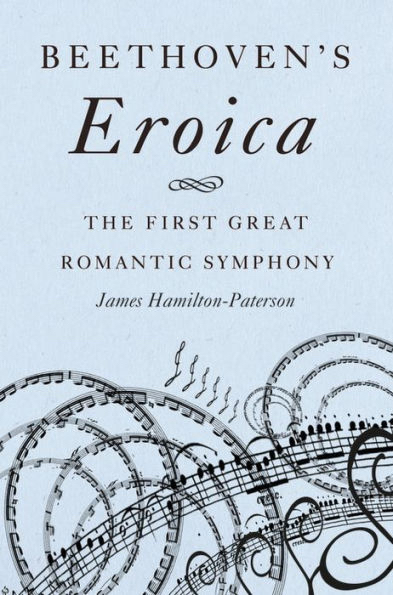
The Sound of the Future
December 11, 2017 | The Barnes & Noble Review
Beethoven was the first great Romantic composer, and if you listen closely you can hear the moment he launched a new era in music. It occurs about a minute into the third movement of his Symphony No. 3, Eroica. After ninety-two bars of indeterminate pianissimo throat clearing, the orchestra suddenly scales upward and erupts in a giddy, triumphant, onrushing scherzo: horns at full cry, timpani shaking the floor, strings bowing furiously. A wonderful video clip from 1978 shows an excited Leonard Bernstein making one of his famous “Lenny leaps” in anticipation of the momentous downbeat. This was not another conventional parlor entertainment of the Classical era — of harmless amusements and polite applause. This unprecedented scale and intensity was something new: music to make you laugh through tears, link arms with your brethren, and face the future with new hope. Beethoven the humanist had arrived.
The Eroica revolutionized music. It elevated symphonies to the prime medium for composers’ most important ideas. Orchestras became larger and symphonies longer and denser. (The first movement of the Eroica is longer than many Classical symphonies in their entirety.) Composers had the space to unspool an idea fully, facing the challenge of unifying a work’s longer movements with common themes. Symphonies also became weightier cultural milestones, imbued with lofty purpose. For example, the eminent scholar Lewis Lockwood writes that with the Eroica‘s second movement, “Beethoven introduces death and commemoration into the genre of the symphony for the first time.” The British writer James Hamilton-Paterson contends that the Eroica replaced the “civilized gaiety” of the Classical Viennese tradition with “a narrative of high ethical struggle that ended in triumph.”
Beethoven’s Eroica, by Hamilton-Paterson, is the latest in a fine trend of recent books giving biographical treatment to canonical musical works. Titles have appeared on Handel’s Messiah, Bach’s cello suites, Shostakovich’s string quartets, and Schubert’s song cycle Winterreise. Hamilton-Paterson, a British novelist known for his inventiveness and wit, offers an illuminating tour through the cultural, historical, and musical journey of Beethoven’s Third. The book is restrained in its enthusiasm and limited in scope, and Hamilton-Paterson necessarily lacks the expert perspective of scholars like Lockwood or Scott Burnham. Yet fans of this symphony will appreciate the book’s astute commentary and lavish illustrations.
Eroica translates to “hero,” and the original hero Beethoven had in mind was of course Napoleon Bonaparte. Beethoven composed the symphony mainly in 1803, but between then and its 1805 premiere, Napoleon cast off his egalitarian robes and named himself dictator. When Beethoven learned of this treachery he famously ripped the title page in half and scratched out the words “intitolata Bonaparte” so heavily that he tore holes in the paper. It is now generally accepted that, whatever his original intentions, Beethoven’s symphony ultimately embodied the spirit not of any individual hero but of the hero as an abstract ideal.
Or perhaps the hero was Beethoven himself? He composed the Eroica after the greatest personal and spiritual crisis of his life. In October 1802 he finally came to terms with being alone and losing his hearing, drafting the Heiligenstadt Testament, an anguished document combining elements of suicide note, last will, and artistic manifesto. In it he grappled with ending his life but vowed to carry on in order to continue his work. Composed the following spring, the Eroica may represent his own personal triumph over unimaginable adversity. Its final movement presents variations on a theme Beethoven recycled from his ballet The Creatures of Prometheus. Hamilton-Paterson points out that “the Promethean myth of the eternally suffering hero” must have resonated with the much-put-upon composer.
Hamilton-Paterson writes that the Eroica was “the nineteenth century’s first major avant-garde work: one that severely challenged both performers and its audiences.” Yet his book never quite fleshes out this key point. It is often remarked that the Third was much longer than other contemporary symphonies. On its face this seems a superficial accomplishment. But length afforded greater space for development: the music was richer and more complex than what had come before. Audacious writing for various instruments filled the score; for instance, the cellos — rarely before that point a melodic instrument — carried the main theme from the opening bars. Rhythmic innovations, especially the use of syncopation, kept listeners off balance. Beethoven toyed with motifs and ideas, exploring them in various keys and with different instrumentations, forestalling their ultimate “true” announcement and thereby enriching that moment considerably. Boston University professor Jan Swafford explains in his biography Beethoven: Anguish and Triumph that in the Third, Beethoven “wants his exposition restless and searching, so its themes need to be fragmentary, incomplete, constantly in flux. From the first airing of the Hero theme forward, each idea will start decisively and then drift, avoiding a sense of closure or clear formal articulation. Everything points forward rather than feeling like an arrival.” The result is a work of unprecedented ambition, radical and bold yet marvelously clear. The world had never heard anything like it.
Some audiences were more prescient than others about the Eroica. One early listener whom Beethoven treated to a piano rendition predicted that “heaven and earth will tremble when it is performed.” Yet other critics derided it as “odd and harsh” and even “morally depraved.” They soon came around. The symphony heralded the beginning of Beethoven’s extraordinary middle period, which included the Emperor Piano Concerto, the Appassionata and Waldstein piano sonatas, and the incomparable Fifth Symphony. Each built on the Eroica. At a stroke, Beethoven had torn away the old conventions and brought music into a new century. His Third Symphony is now over 200 years old. It still sounds like the future.